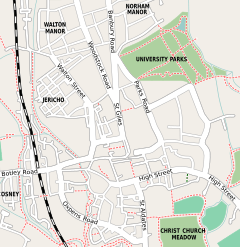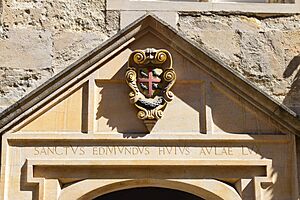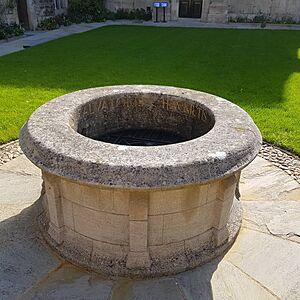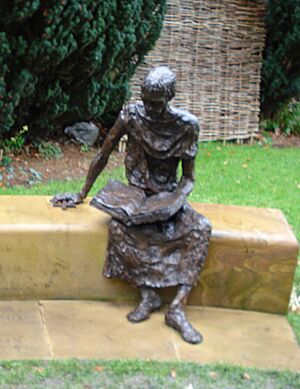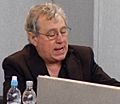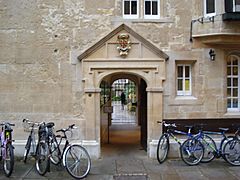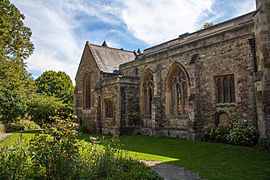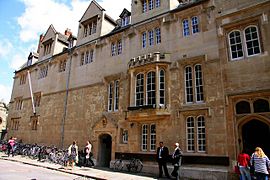St Edmund Hall, Oxford facts for kids
Quick facts for kids St Edmund Hall |
||||||||||||
|---|---|---|---|---|---|---|---|---|---|---|---|---|
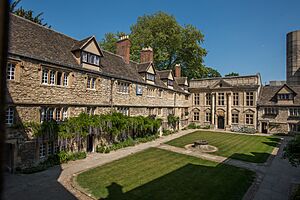
St Edmund Hall Front Quad 2018
|
||||||||||||
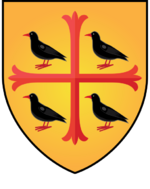
Blazon: Or, a cross patonce gules cantoned by four Cornish choughs proper
|
||||||||||||
|
|
||||||||||||
| University | Oxford | |||||||||||
| Location | The High / Queen's Lane | |||||||||||
| Coordinates | 51°45′11″N 1°15′00″W / 51.753°N 1.25°W | |||||||||||
| Full name | The Principal, Fellows and Scholars of Saint Edmund Hall in the University of Oxford | |||||||||||
| Latin name | Aula Sancti Edmundi | |||||||||||
| Established | c. 1278 | |||||||||||
| Named for | Edmund of Abingdon | |||||||||||
| Sister college | Fitzwilliam College, Cambridge | |||||||||||
| Principal | Kathy Willis | |||||||||||
| Undergraduates | 376 | |||||||||||
| Postgraduates | 315 | |||||||||||
| JCR | SEH JCR | |||||||||||
| MCR | SEH MCR | |||||||||||
| Boat club | SEH boatclub | |||||||||||
| Map | ||||||||||||
St Edmund Hall (also called The Hall or Teddy Hall) is one of the colleges that make up the University of Oxford. It claims to be the oldest place that has continuously housed and taught university students. It was also the last of the old medieval "academic halls" at the university.
The college is located in central Oxford, on Queen's Lane and the High Street. For over 700 years, only men could study there. But in 1979, it started accepting both men and women. In 2019, the college had over £65 million to help support its work.
Many famous people have studied at St Edmund Hall. These include diplomats like Mark Sedwill and politicians like Keir Starmer. Journalists like Samira Ahmed and Anna Botting also went there. The college is working to help more students get into higher education. It also wants to offer more scholarships and improve its buildings.
Contents
History of St Edmund Hall
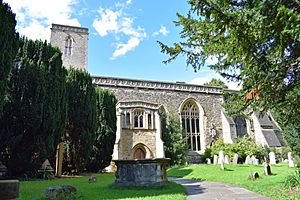
It's not clear exactly when St Edmund Hall started. But it's thought to be around 1236. This was before any other Oxford college was officially created. The college is named after Edmund of Abingdon. He was the first known Oxford Master of Arts. He later became the Archbishop of Canterbury. Edmund lived and taught on the college site as early as the 1190s. The name St Edmund Hall (Aula Sancti Edmundi) was first used in 1317.
In the 1200s, the university wanted teachers to rent places for students to live. This was better than private lodgings. These private places were linked to bad behavior. The university wanted more control over where students lived. Principals (the people in charge of the halls) had to promise to pay rent each year. Halls that did this were known as academic halls.
St Edmund Hall was first rented from Osney Abbey. This was a large religious group nearby. The rent was 35 shillings a year. This suggests it was a small to medium-sized hall. By 1324-25, the rent went up. This means the hall likely got bigger after 1318. It gained more land and buildings. This also gave it access to the well in the main courtyard.
St Edmund Hall was one of Oxford's original "Aularian houses." These were medieval halls that helped start the university. Since it's the only one left, its members are called Aularians.
Early Challenges and Independent Thinking
The college has a history of thinking differently. This often led to disagreements with the Church and the government. In the late 1300s and early 1400s, it was a center for followers of John Wycliffe. These people were called Lollards. They questioned the Pope's power. They also disagreed with practices like priests not marrying. The Lollards believed everyone should be able to read the Bible. They were known for translating the Bible into English. Lollard ideas later mixed with Protestantism in the 1500s. This led to King Henry VIII's English Reformation.
William Taylor
William Taylor was a principal of the Hall. He was a Lollard preacher. The Archbishop of Canterbury, Thomas Arundel, did not like Lollard ideas. Taylor was excommunicated, meaning he was kicked out of the Church. He was later arrested for his beliefs. In the end, he was declared a heretic and burned at the stake.
Peter Payne
Taylor's replacement, Peter Payne, was also a Lollard. He continued to support Wycliffe's ideas. Payne was known for defending Wycliffe's Bible translations. He also caused trouble by using the university's official seal. He used it to send a letter to a reformer in Prague, Jan Hus. The letter claimed that Oxford supported Hus's ideas. This made the friars in Oxford very angry.
Archbishop Arundel thought the college's activities were dangerous. He banned Oxford schools from using Wycliffe's texts. He also ordered principals to check their scholars' beliefs monthly. The King then ordered that anyone with reformist ideas be put in prison. Payne left Oxford in 1412 and fled the country.
From the 1600s Onwards
In the late 1600s and 1700s, St Edmund Hall again faced problems with the Crown. It supported "non-jurors." These were people loyal to the House of Stuart royal family. They refused to promise loyalty to the new rulers after 1688.
In 1877, Prime Minister Benjamin Disraeli wanted to reform Oxford University. Commissioners decided that the four remaining medieval halls were not strong enough. They thought these halls should join bigger colleges. By 1903, only St Edmund Hall was left. There were plans for it to merge with Queen's College. But these plans were rejected. In 1912, a law was passed that kept the Hall independent.
In 1957, Queen Elizabeth II approved St Edmund Hall becoming a full college. But it kept its old name, "Hall." The Duke of Edinburgh presented the royal charter in 1958.
In 1978, women were first allowed to join the Hall. The first women students started in 1979. In 2015, the college celebrated its 3000th female student. They displayed portraits of important women who had studied or worked there.
Buildings and Grounds
St Edmund Hall is in central Oxford. It's on the north side of the High Street, near Queen's Lane. The main courtyard has the porters' lodge (where you enter). It also has the Old Dining Hall, built in the 1650s. There's a college bar, the chapel, the Old Library, offices, and student rooms.
College Entrance
Above the entrance on Queen's Lane, you can see the college's coat of arms. Below it is a Latin message: "sanctus edmundus huius aulae lux." This means "St Edmund, light of this Hall."
Universities often use "chronograms" in their dedications. These are Latin phrases where Roman numerals are hidden. When you add up the Roman numerals in the Hall's dedication, they equal 1246. This is the year St Edmund of Abingdon became a saint.
The Medieval Well
In the middle of the main courtyard is a medieval well. It was found in 1926 when new buildings were being made. People believe this is the same well that St Edmund himself used. A new wellhead was added. It has a Latin inscription from the Bible: "haurietis aquas in gaudio de fontibus salvatoris." This means "with joy, draw water from the wells of salvation." These words are thought to be what St Edmund said before he died. A metal grate covers the well for safety.
The Chapel
The chapel is on the east side of the main courtyard. It was made official in 1682. Inside, there's a stained glass window. It's one of the first works by famous artists Sir Edward Burne-Jones and William Morris. Above the altar is a painting called Supper at Emmaus by Ceri Richards. This painting celebrates the college getting its Royal Charter. The St Edmund Hall Chapel Choir has eight scholarship singers and many other singers. The choir goes on two trips each year. They have visited Wells Cathedral and Pontigny Abbey in France, where St Edmund is buried.
Old Library
Above the chapel is the Old Library. It was one of the last Oxford colleges to chain its valuable books. But it was the first to have shelves built against the walls. The Old Library is now used for events and research. It's not the main library anymore.
College Library
The college's main library is in the old 12th-century church of St Peter-in-the-East. It was turned into a library in the 1970s. It has a 14th-century tower. The oldest part of the library is the crypt, which is from the 1130s. The library has 40,000 books for all the different courses offered. Some old gravestones are still there. One belongs to James Sadler, the first English person to fly in a balloon. The garden has a bronze statue of St Edmund as a poor student.
Modern Buildings
In 1934, new buildings were added to the south side of the main courtyard. This marked 700 years since Edmund of Abingdon became Archbishop of Canterbury. From 1965 to 1969, more new buildings were added. These include a new dining hall, common rooms, teaching areas, and student housing. These are at the back of the main site. All first-year students live on the main site. Many return for their third year. The Wolfson Hall is the dining hall. It can seat about 230 people. Students use it daily for meals.
Student Housing Outside the Main Site
The college also has student housing in other areas. These are called annexes. They are located at Norham Gardens, on Dawson Street, and on Iffley Road.
The Norham Gardens annexe has the Graduate Centre. This is a group of large old houses. Most first-year graduate students can live here. It has its own common room, computer facilities, gardens, and gym. The Dawson Street and Iffley Road annexes house undergraduate students. These rooms have their own bathrooms and kitchens.
Student Life
As of 2017, St Edmund Hall has about 410 undergraduate students and 300 graduate students. It also has 75 Fellows (teachers and researchers). Students are part of different "common rooms." The Junior Common Room (JCR) is for undergraduates. The Middle Common Room (MCR) is for graduate students. Both groups organize events like Freshers' week, dinners, and movie nights. The college is known for its strong "Hall Spirit." Many students come to cheer on their teams in sports competitions.
Creative Writing
The college has a weekly creative writing workshop. It also has a poetry reading series each term. There's an online writers' forum and The St Edmund Hall Gallery. This is an annual magazine for student art and writing. Students also run 'TART' or 'Teddy Art', another arts magazine.
The college holds an annual journalism competition for Oxford students. It's in memory of Philip Geddes. He was a promising young journalist and alumnus who died in 1983. The college also hosts a yearly lecture in his name.
Drama
St Edmund Hall has an active drama society called the John Oldham Society. In 2013, they worked on a community drama project in Cameroon. In 2017-18, the college's play reached the final round of a university competition. In 2019-20, the society put on a play that sold out. The money raised was given to a charity.
Music
The college has one of the largest college choirs in Oxford. You don't need to audition to join. The choir performs every Sunday and on special occasions. These include the Feast Day of St Edmund and "Carols in the Quad" at Christmas. The choir goes on an annual exchange with Fitzwilliam College, Cambridge. They also visit Pontigny, France, each year to perform.
Sport
St Edmund Hall takes part in many sports. These include rugby, football, rowing, tennis, cricket, and more. Since becoming a college in 1957, the Men's Rugby Union team has won over half of the university tournaments they've entered. In 2015–2016, Teddy Hall won women's rugby. In 2016–2017, St Edmund Hall won men's football and cricket. Its women's first boat and men's second boat won "blades" in rowing races. In 2017-2018, the college won men's basketball, swimming, men's rugby, women's rugby, rounders, and pool.
The St Edmund Hall Boat Club (SEHBC) was very successful in rowing in the 1960s. They won the men's headship (top position) in Summer Eights five times. The women's headship was won from 2006 to 2009. SEHBC also had success at the Henley Royal Regatta.
- In 1965, SEHBC won two events at Henley. The first men's boat won The Ladies' Challenge Plate. A coxless boat won the Visitors' Challenge Cup.
In 2023, the Hall won Octopush (underwater hockey) for the first time. The St Edmund Hall A swimming team also won their university competition in 2023.
The college celebrates student successes in sports and arts. They have an annual Achievements Dinner. Winning teams get their photograph put up in the college bar. The college also gives the Luddington Prize. This is for undergraduate students who get a top degree and a university "Blue" (a top award for sports).
Outreach Programs
The college has a very active outreach program. It helps students from different backgrounds apply to university. It has two full-time staff and over 30 student volunteers. They work with schools in specific areas, like Leicestershire and Derbyshire. The college hosts school visits. It was also one of the first colleges to send student ambassadors to schools. These students visit schools to talk about university life. The college has also started a program called Unlock Residential. This aims to increase applications from its link areas.
Formal Hall and College Graces
Before dinner at Formal Hall, a special prayer is said. It is:
- Benedictus Benedicat per Jesum Christum Dominum Nostrum
- (May the Blessed One bless [this food] through Jesus Christ Our Lord)
After dinner, another prayer is said:
- Benedicto Benedicatur per Jesum Christum Dominum Nostrum
- (May the Blessed One be blessed through Jesus Christ Our Lord)
Everyone responds with "Amen." Longer prayers are sometimes used for special events. These include the Feast of St Edmund.
The traditional college toast is "Floreat Aula." This is Latin for "May the Hall Flourish."
People Connected to the College
Notable Alumni
-
Bongbong Marcos (special diploma)
Other Notable Figures
- Edmund of Abingdon
- Jeremy Paxman, a Fellow of the College.
Principals
- 1405–1406 William Taylor, a theologian and priest, excommunicated and executed as a Lollard.
- 1410–1414 Peter Payne, a theologian and diplomat, also a Lollard.
- 1565– Thomas Lancaster, a Protestant clergyman.
- 1609-1610 John Waldron
- 1610–1631 John Rawlinson, a clergyman.
- 1658–1676 Thomas Tully
- 1685–1707 John Mill, a theologian.
- 1751–1760 George Fothergill
- 1722–1740 Henry Felton, a clergyman and academic.
- 1740–1751 Thomas Shaw
- 1864–1903 Edward Moore
- 1913–1920 Henry Williams, later Bishop of Carlisle.
- 1914–1918 Leonard Hodgson (Vice-Principal)
- 1920–1928 G.B. Allen
- 1928 George B. Cronshaw
- 1929–1951 Alfred Brotherston Emden
- 1951–1979 J. N. D. Kelly, a clergyman.
- 1979–1982 Sir Ieuan Maddock
- 1982–1996 J C B Gosling
- 1996–1998 Sir Stephen Tumim
- 1999–2009 Michael Mingos, Professor of Inorganic Chemistry.
- 2009–2018 Keith Gull, a Fellow of the Royal Society.
- 2018–present Kathy Willis
Fellows
- Further information: and List of Honorary Fellows of St Edmund Hall, Oxford
Gallery
See also
 In Spanish: Saint Edmund Hall para niños
In Spanish: Saint Edmund Hall para niños


